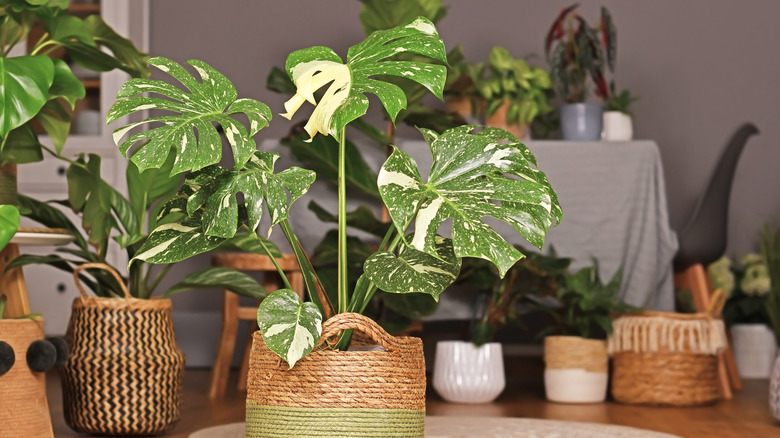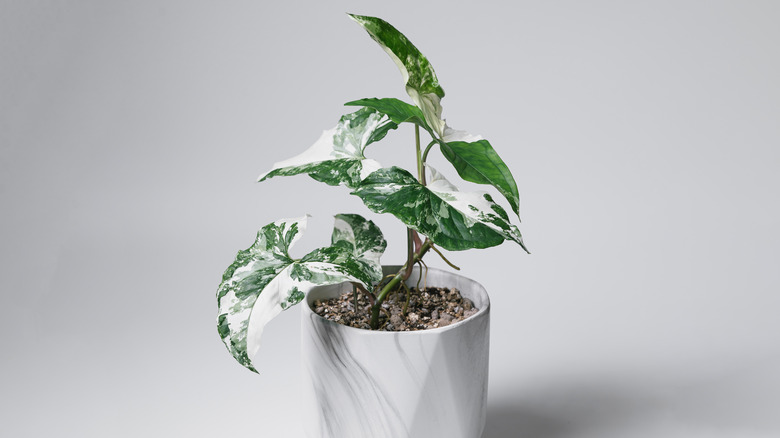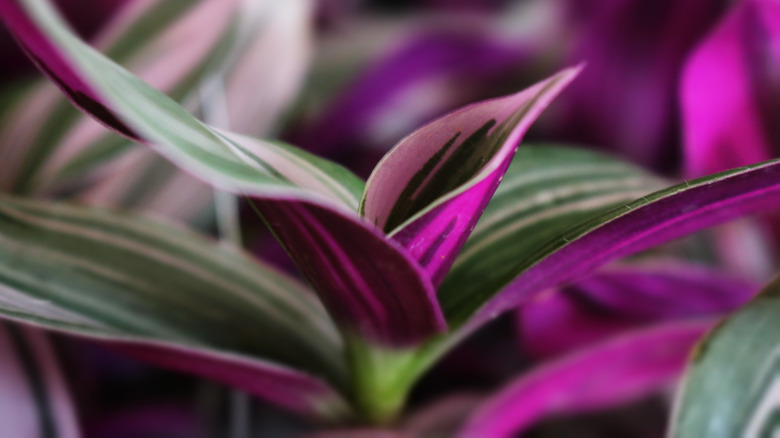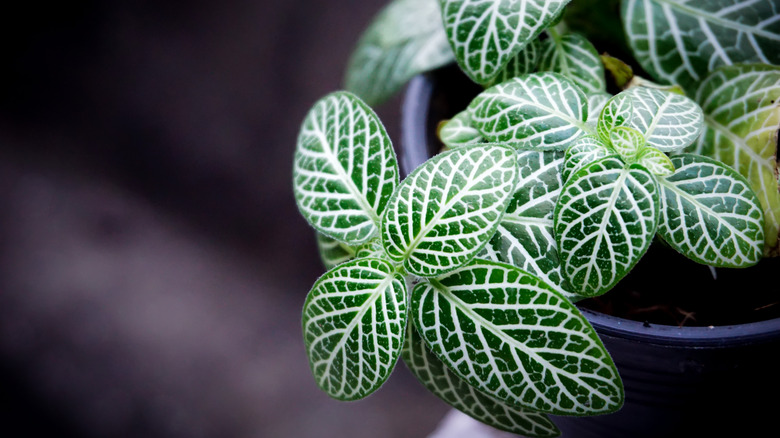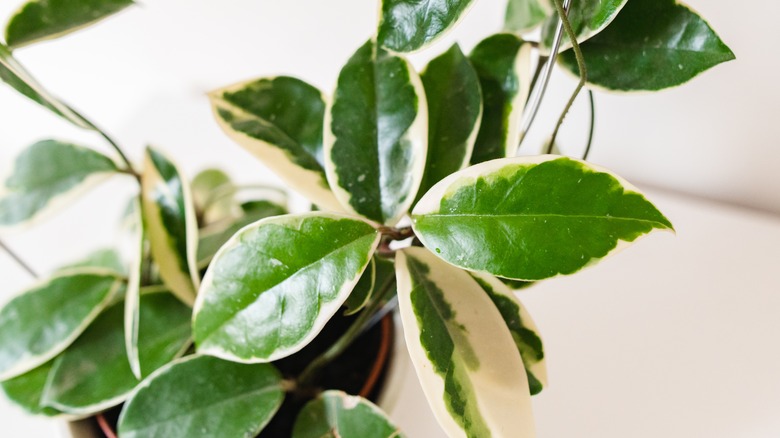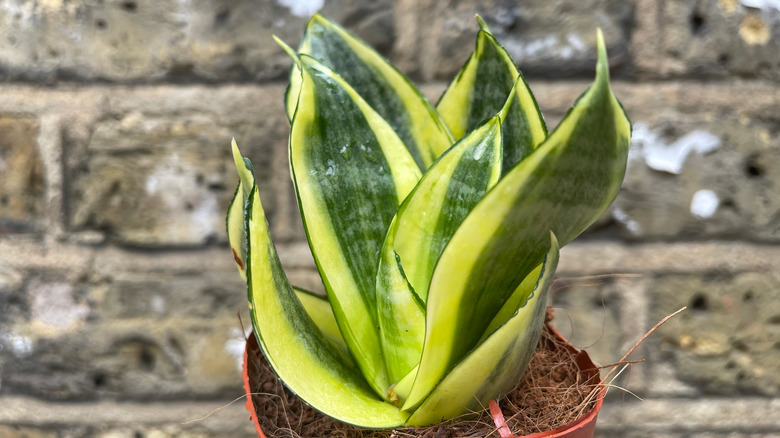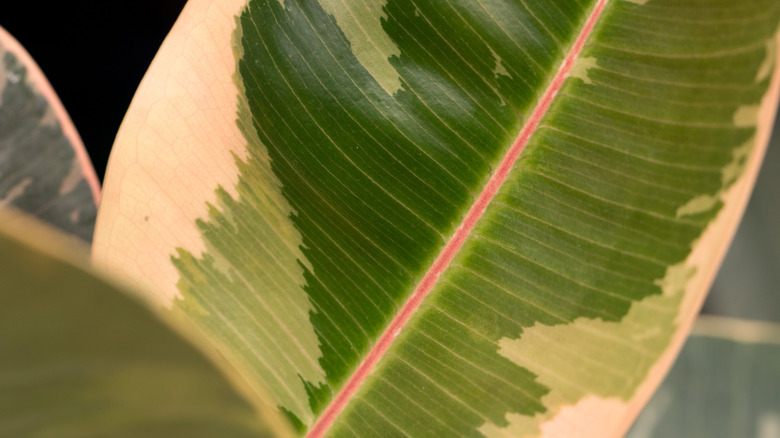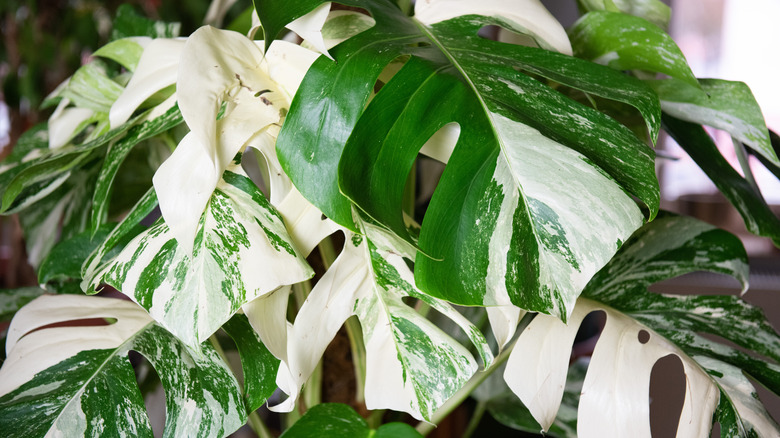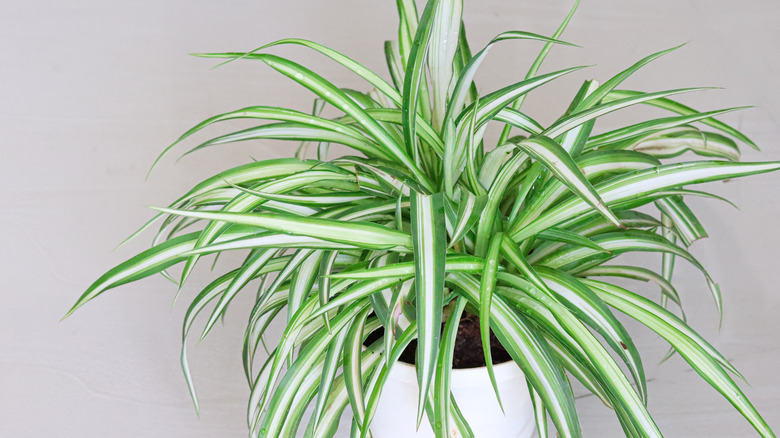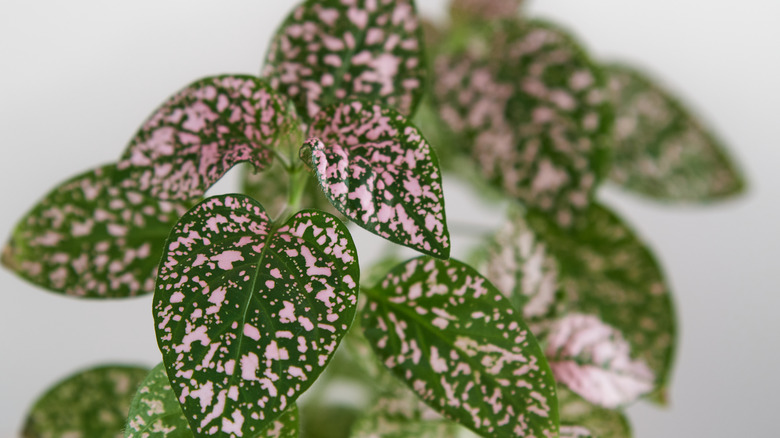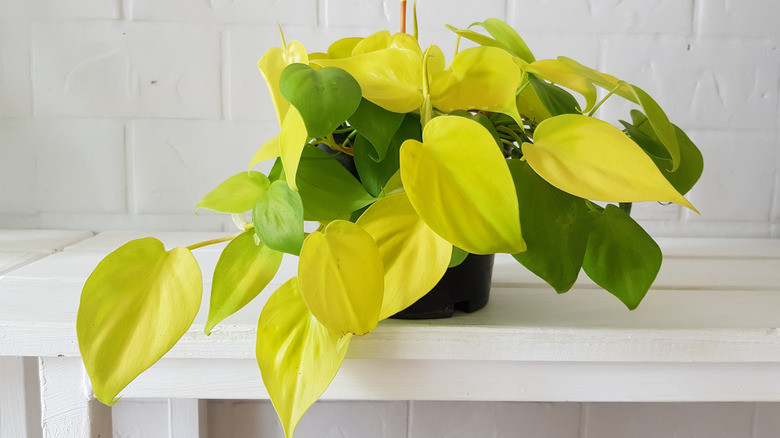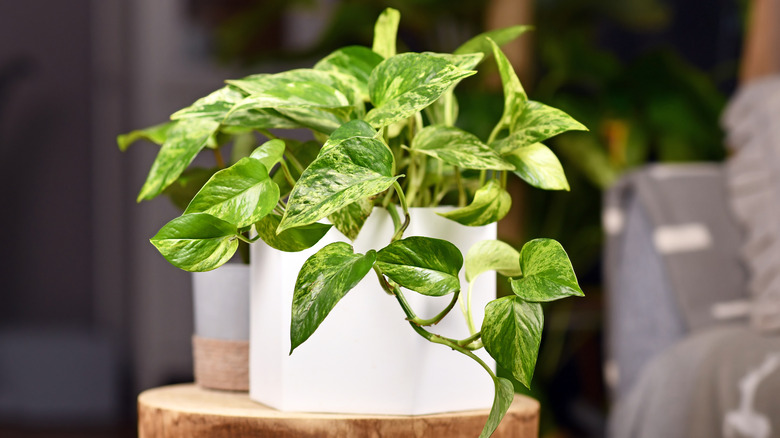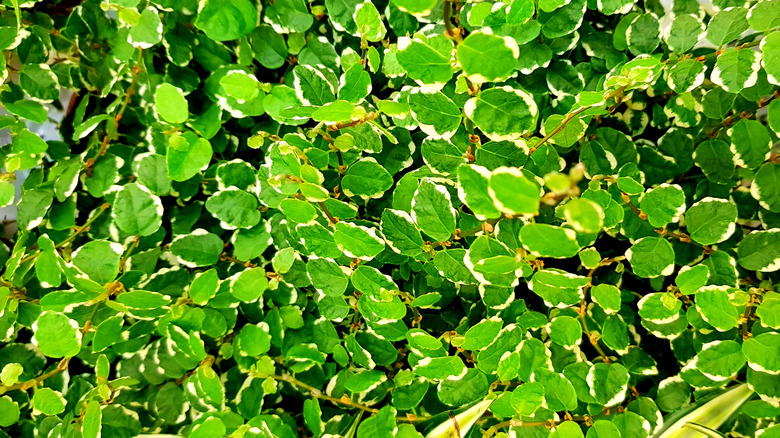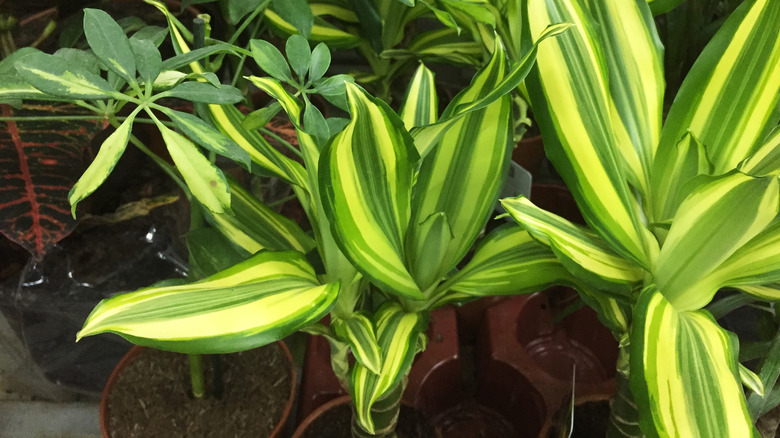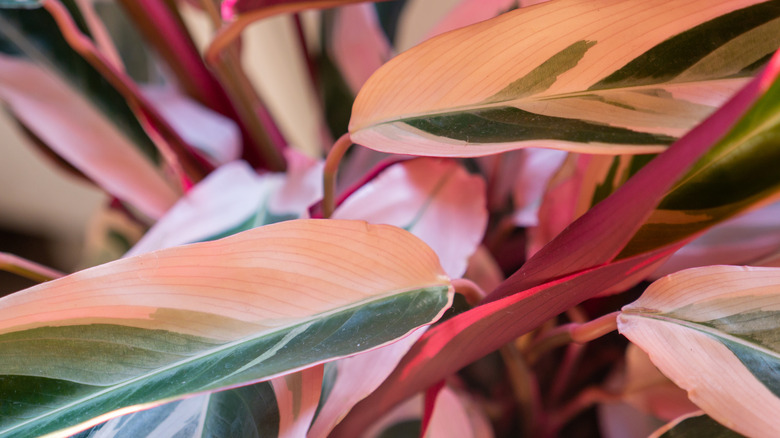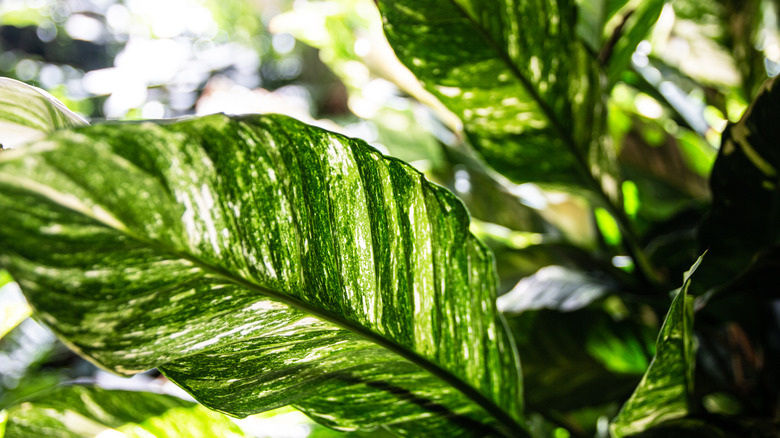15 Variegated Plants To Spruce Up Your Indoor Spaces
When shopping for houseplants, many of us home gardeners look for the most colorful and unique cultivars that will contrast well with the foliage-filled favorites that we already own. If your collection is becoming overgrown with strictly green plants, try adding some drama to your shelves with some brighter options. People unfamiliar with variegated plants sometimes believe that they only come in shades of green and white. However, many cultivars show off pink, red, burgundy, yellow, and gold coloring.
In this collection, we describe several distinct variegated plants of different types. As pointed out by Pistils Nursery, the most common type of variegation is known as chimeral variegation. This is where the plant features splotches of random colorful and colorless zones all over its leaves. Two other types of this mutation include pattern-gene, which is commonly seen on prayer plants, and blister or reflective variegation, shown on the leaves of many silver vine plants and anthurium species.
Easy-to-find cultivars of variegated pothos, snake plants, and spider plants should be available at your local nursery. However, plants that are even more show-stopping, such as variegated philodendron, nanouk tradescantia, and variegated hoya, tend to be rarer finds.
1. Variegated arrowhead vine
The variegated arrowhead vine (Syngonium podophyllum 'Albo variegata') is a climbing plant that adds bright color and interesting shapes to any sunny room. According to RHS, this plant can be identified by its arrow-shaped leaves and aerial roots, which help them climb your walls, shelves, and poles.
Bloom Season: Summer
USDA Growing Zone: 10 to 12
Growing Conditions: Bright indirect light
Soil Type: Well-drained potting mix
Size: Up to 7 feet tall
2. Nanouk tradescantia plant
Nanouk tradescantia plants (Tradescantia nanouk) are a rare species of houseplants in the spiderwort family. Grown indoors, this variegated cultivar shows off multicolor, green, white, pink, and purple leaves that enjoy medium to bright indirect light, as told by Costa Farms. Place your nanouk tradescantia plant on a bright tabletop to enjoy its beautiful foliage and air-purifying abilities.
Bloom Season: Spring to fall
USDA Growing Zone: 9 to 12
Growing Conditions: Medium to bright indirect light
Soil Type: Well-drained potting mix
Size: 6 to 9 inches tall and 9 to 24 inches wide
3. Nerve plant
Nerve plants (Fittonia albivenis) are well-known for their lined leaves, which can feature veins in white, pink, or red. A tropical plant, this slow-growing houseplant needs some indirect light and consistently warm temperatures. As far as indoor plants go, the nerve plant can be quite finicky when it comes to drafts, dry air, and direct sunlight, as warned by North Carolina State Extension.
Bloom Season: Spring and summer
USDA Growing Zone: 9 to 11
Growing Conditions: Bright to medium indirect light
Soil Type: Well-drained potting mix
Size: 12 to 15 inches tall
4. Hoya
Hoya (Hoya carnosa "Albomarginata"), also known as the porcelain flower or wax plant, is another climbing houseplant that is commonly grown for its gorgeous leaves as well as its fragrant flowers and ability to grow in low light conditions, as noted by North Carolina State Extension. Hoya plants such as the albomarginata variety are frequently grown in containers and hanging planters, or they can be trained to climb on a trellis.
Bloom Season: Spring and summer
USDA Growing Zone: 10 to 12
Growing Conditions: Medium to low indirect light
Soil Type: Well-drained potting mix
Size: 15 inches long
5. Snake plant
The snake plant (Sansevieria trifasciata "Golden Hahnii"), which is sometimes called mother-in-law's tongue, is a wonderful houseplant for beginner gardeners. There is a wide range of options when it comes to variegated cultivars, as pointed out by Penn State Extension. Some of the most popular include "Laurentii," "Moonglow," and "Bantel's Sensation."
Bloom Season: Spring
USDA Growing Zone: 9 to 11
Growing Conditions: Bright indirect light
Soil Type: Well-drained cactus potting mix
Size: 6 inches to 3 feet tall depending on the variety
6. Rubber plant
The rubber plant (Ficus elastica "Doescheri") has many different cultivars that show off their foliage in shades of red, green, cream, pink, and more. The "Doescheri" variety, in particular, is variegated with white to gray leaves that are outlined by pink ribs, describes Clemson Cooperative Extension. With minimal care requirements, a variegated rubber plant is a great option for gardeners looking to brighten their homes with colorful foliage.
Bloom Season: Spring and summer
USDA Growing Zone: 10 to 11
Growing Conditions: Bright, medium to low indirect light
Soil Type: Well-drained potting mix
Size: 6 to 10 feet tall
7. Monstera
If you own any houseplants, you are probably familiar with monstera plants (Monstera deliciosa). This popular indoor species is host to cultivars such as 'Variegata' and 'Albovariegata,' which have variegated foliage. Their leaves tend to grow smaller than other varieties of the swiss-cheese plant. But, according to the University of Wisconsin-Madison, monstera plants can grow larger when provided with the right conditions.
Bloom Season: Rarely flowers indoors
USDA Growing Zone: 10 to 12
Growing Conditions: Bright to medium indirect light
Soil Type: Well-drained and organic potting mix
Size: Up to 15 feet tall indoors
8. Spider plant
Spider plants (Chlorophytum comosum) are among the most commonly grown variegated houseplants that we see each day. As told by the University of Wisconsin-Madison, the spider plant has several variegated cultivars that are just as easy to grow as the most common variety. Give this plant plenty of sunlight and minimal water to watch it flourish with bright cream, green, and yellow colors.
Bloom Season: Spring and summer
USDA Growing Zone: 9 to 11
Growing Conditions: Medium to bright light
Soil Type: Well-drained potting mix
Size: 12 to 15 inches tall
9. Polka dot plant
The polka dot plant (Hypoestes phyllostachya), which is native to the warm and tropical country of Madagascar, is known for its colorful splash series, which features splotches of white, pink, and red variegation on green leaves. As mentioned by Missouri Botanical Garden, most polka dot plants with this special coloring are grown indoors as unique houseplants near a bright window.
Bloom Season: Summer
USDA Growing Zone: 10 to 11
Growing Conditions: Bright indirect light
Soil Type: Well-drained and organic potting mix
Size: 12 to 24 inches tall and 9 to 12 inches wide
10. Heart-leaf philodendron
Heart-leaf philodendron (Philodendron hederaceum), or parlor ivy, is a climbing vine that produces heart-shaped leaves. Typically, the plant is raised for its glossy, green foliage, as per North Carolina State Extension, but the rare "Birkin" variation is collected by houseplant owners for its white variegated pinstripe veining.
Bloom Season: Spring and summer
USDA Growing Zone: 10 to 11
Growing Conditions: Bright indirect light
Soil Type: Well-drained potting mix
Size: 4 inches to 6 feet long
11. Variegated pothos
Pothos (Epipremnum aureum), which is also characterized by heart-shaped leaves, is more easily found with variegated foliage. Common pothos cultivars include pothos neon, golden pothos, and pothos marble queen, says The Sill. Each of these plants has white, cream, or yellow variegated leaves, and they are likely available at your nearest nursery.
Bloom Season: Does not flower
USDA Growing Zone: 10 to 12
Growing Conditions: Bright, medium to low indirect light
Soil Type: Well-drained potting mix
Size: 6 to 10 feet long when grown indoors
12. Creeping fig
Creeping figs (Ficus pumila variegata) are ficus plants that are easily grown indoors and outdoors, says Monrovia. They can be used to cover a fence, hang off of a shelf, or cascade from a hanging basket. This plant clings to trellises and walls without tedious training; however, when growing it indoors, you should protect your walls from its aerial roots.
Bloom Season: Rarely blooms indoors
USDA Growing Zone: 9 to 11
Growing Conditions: Medium to bright light
Soil Type: Well-drained potting mix
Size: 10 to 15 feet tall, smaller when grown indoors
13. Corn plant
A member of the Asparagaceae family, the corn plant (Dracaena fragrans "Lemon Lime") boasts fragrant foliage and flowers. When grown inside the home, the fragrant dracaena can be monitored for its leaf color, which should stay neon yellow and neon green when the plant is placed in an area where it receives bright indirect light and plenty of humidity, as said by Missouri Botanical Garden.
Bloom Season: Rarely blooms indoors
USDA Growing Zone: 10 to 12
Growing Conditions: Bright indirect light
Soil Type: Well-draining potting mix
Size: 15 to 50 feet tall and 3 to 10 feet wide
14. Triostar stromanthe
Triostar stromanthe (Stromanthe sanguinea 'triostar') is an exotic houseplant that is prized for its colorful foliage in shades of burgundy, green, and cream. Unlike other tropical plants in this collection, triostar stromanthe prefers to live in a shady corner of your home where it will grow quickly if you keep it humid, as explained by Monrovia.
Bloom Season: Spring
USDA Growing Zone: 10 to 11
Growing Conditions: Low indirect light
Soil Type: Well-drained potting soil
Size: Up to 3 feet tall and 2 feet wide
15. Domino lily
The domino lily (Spathiphyllum "Domino") is a flowering variegated plant that you can enjoy year-round inside your home. It is mostly indistinguishable from the common peace lily, but it does have one stark difference. The domino lily can be identified by its glossy green leaves that are speckled with white splashes, as described by Clemson Cooperative Extension.
Bloom Season: Spring
USDA Growing Zone: 10 to 11
Growing Conditions: Bright indirect light
Soil Type: Well-drained potting mix
Size: 1 to 6 feet tall
